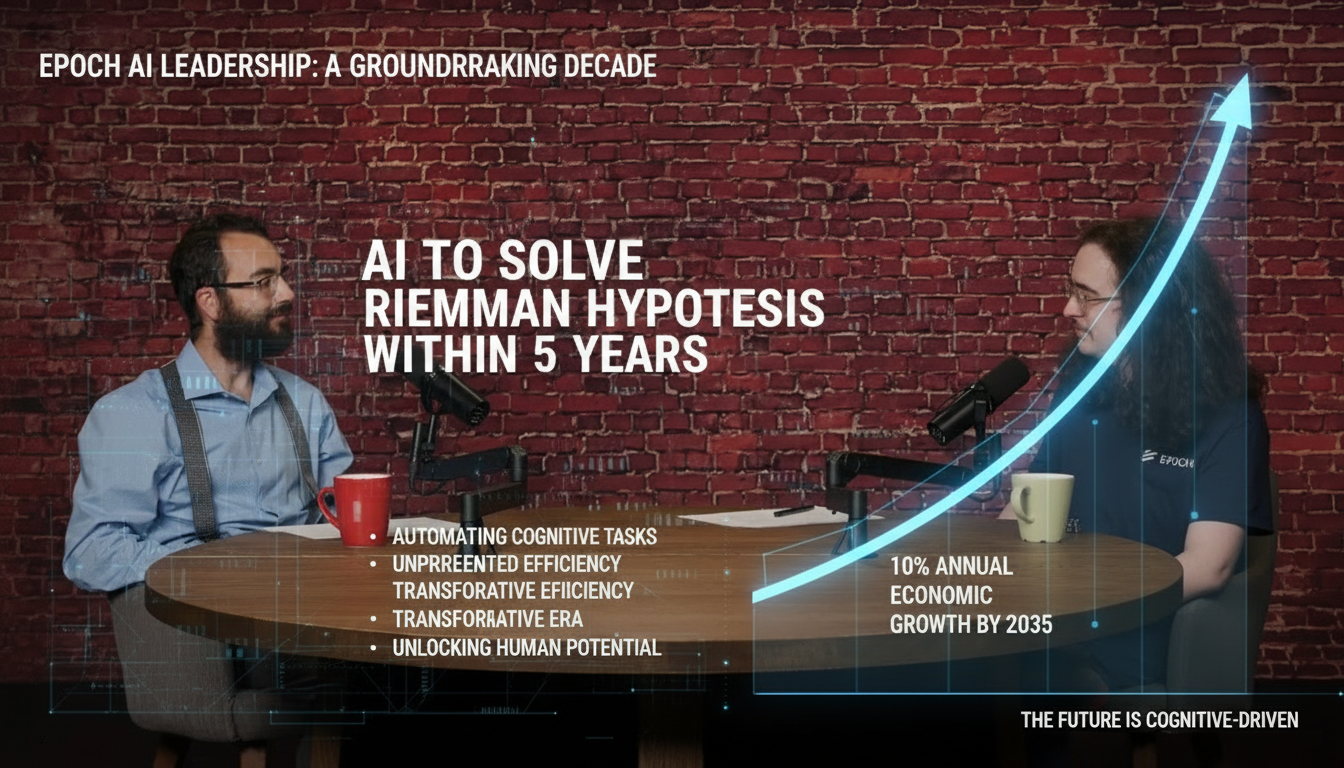Artificial intelligence is poised for an unprecedented surge in capability, with predictions suggesting it could solve profound mathematical conjectures like the Riemann Hypothesis within five years and fundamentally reshape human cognition and the global economy within the next decade. This bold outlook comes from Epoch AI leadership, who shared their roadmap for AI’s trajectory in a recent podcast interview.

Jaime Sevilla (left) and Yafah Edelman (right) of Epoch AI.
The discussion, featuring Epoch AI’s head Jaime Sevilla and data and analytics lead Yafah Edelman, delved into critical questions about the future of AI, including:
- Will the current 5x annual compute expansion pace be sustainable?
- When will AI be able to automate virtually all “cognitive tasks” at a cost comparable to or lower than humans?
- Will the economy experience a slowdown or a boom by 2030?
- What kind of world will AI usher in a decade from now?
Sevilla projected that by 2035, AI could drive economic growth to an astonishing 10% annually. He humorously noted this prediction would likely elicit a mixed reaction: economists might deem it outlandish, while those in the AI field might consider it conservative.
The Pace of Compute Expansion: Can 5x Annually Last?
The conversation addressed the sustainability of the current ~5x annual increase in AI compute power. Yafah Edelman suggested that this exponential growth rate is likely to decelerate within the next two years, potentially even slowing down already, partly due to the extensive time required for data center construction.
Even factoring in ambitious public plans like OpenAI’s “Stargate” and “Abilene” projects, Edelman expressed doubt that the 5x annual growth could be maintained. The drivers of this expansion are shifting, she explained. Edelman anticipates that training runtimes are already extending to “months,” and without this increase in duration, the annual compute growth might be closer to 2.5x-3x.
Taking Grok 4 as an example, Edelman doesn’t foresee its new compute requirements significantly exceeding those of Grok 3’s training. Instead, Grok 4 represents an advancement built upon Grok 3, likely benefiting from shorter training times with increased GPU allocation.
Due to algorithmic advancements and accelerated product development cycles, Edelman doesn’t expect training times to continue lengthening, considering a 3-to-6-month training window to be reasonable. However, she acknowledged potential for further expansion, citing the possibility of using more GPUs for training runs like Grok 3/4. She also noted that with “Stargate,” OpenAI could potentially maintain the 5x annual pace for another year or two if they “step on the gas,” but a slowdown is inevitable afterward.
AI in 2030: Capabilities and Discoveries
By 2030, what kind of AI can we expect with this rapid compute growth? Sevilla inquired if the largest training runs could reach $10^29$ FLOPs. Edelman believes this is achievable, equating it to thousands of times the compute power used for training models like GPT-4.
At this scale, Edelman anticipates the emergence of highly capable “AI agents” characterized by their ability to reliably perform simple computer tasks with extreme efficiency and at a significantly reduced cost. Crucially, “low-level reasoning errors and confusion” are expected to diminish substantially.
Beyond task automation, these advanced AIs are likely to contribute to new discoveries in fields like mathematics and physics. Sevilla predicts that by 2030, a prominent unsolved problem, such as the Riemann Hypothesis, could be largely resolved by AI, a sentiment Edelman strongly agrees with, highlighting AI’s particular aptitude for such challenges.
The Rise of AI Programmers and the Future of Engineering
Sevilla discussed the transformative impact of “AI programmers,” citing examples like AI generating weekend activity plans and even creating accompanying invitation applications. He noted that AI’s code quality may surpass human levels, potentially reaching a point where AI-generated code requires minimal human oversight.
This shift is likely to be embraced by the market. Companies leveraging AI could offer superior products at lower prices, making them highly attractive to consumers. When AI automates many entry-level positions, a peculiar equilibrium may emerge: hiring individuals essentially means tasking them with using AI, when direct AI utilization would be more efficient.
Consequently, the role of engineers is expected to evolve from direct code development to higher-level strategic functions such as product positioning, architecture design, testing, and system building. Their focus will shift to “directing technology” rather than “building it themselves.” While managing AI outputs won’t consume excessive time, Edelman emphasized that prolonged communication with an AI often indicates its current inability to fully grasp desired outcomes.
2030 Economic Outlook: Slowdown or Supercharged Growth?
Currently, AI companies generate revenues in the “billions of dollars,” with approximately 3x annual growth. While maintaining this pace is challenging, doubling revenue annually until 2030 is not out of the question. Sevilla pointed out that if AI companies can achieve hundreds of billions in annual output, it could more than double the global economic growth rate, which has averaged around 2% over the past 70 years.
However, Edelman cautioned about potential economic bubbles fueled by rapid technological expansion. The next decade could see trillions invested in compute, GPUs, manufacturing, infrastructure, and data centers, but she expressed uncertainty about whether GPU investments will directly translate into GDP gains. She drew parallels to historical technological booms and investment uncertainties, such as the dot-com bubble and the British railway mania, highlighting the risks inherent in periods of rapid expansion and intense investment.
Sevilla outlined two potential scenarios for 2030: a significant and prolonged economic slowdown, or accelerated growth driven by increased automation. Edelman proposed a two-stage view:
- Infrastructure Expansion Phase: This phase of growth is sustainable, though she’s uncertain how long it will last, considering 2030 a potentially aggressive timeline.
- Potential Explosive Economic Growth: Defined as at least 30% annual GDP growth, this scenario becomes plausible if AI can automate all job sectors. The precise automation threshold for triggering such growth remains unclear.
Edelman stressed that sustained growth hinges on continuous automation.
Automating Cognition and the Dawn of a Faster World
Both Edelman and Sevilla largely agree that AI will achieve the capability to automate virtually all “cognitive tasks” at a cost no higher than human labor by 2034 to 2035.
Looking beyond 2035, Sevilla attributes the speed of AI advancement to three key factors: the pace of robot manufacturing, economies of scale in technology, and the rate of intelligence growth (achieving superintelligence).
He expressed a degree of skepticism regarding the speed of technological and intelligence returns. The primary challenge in robot manufacturing, he noted, lies in production costs, emphasizing the need for upfront investment to ensure sufficient robotic resources are available as AI capabilities mature.
Edelman believes robotic production will significantly amplify AI investment. Even a $100 billion investment, with each robotic “body” costing $100,000, would only yield one million robots – likely insufficient. Reducing production costs hinges on the effectiveness of “AI-driven R&D,” which is crucial for accelerating robot manufacturing itself. Furthermore, she suggested that a few hundred thousand robots, rather than millions, might be enough to significantly alter the production curve.
From now until the end of the decade, AI’s sustained “frenetic expansion” is expected to be a major economic driver. By 2030, while a small fraction of “long-tail cognitive abilities” may remain unautomated, the trajectory suggests this gap will close. Expansion may become more challenging but will not cease, propelling us into a “faster world.”
Sevilla summarized the transition to this “faster world” in three phases:
- Era of Scale: 2025 to 2030
- Era of Commoditization/Ubiquity: 2030 to 2035, driving growth rates to at least 10% and potentially automating all cognitive tasks.
- AI Economy Era: Between 2035 and 2040 or 2045, when AI becomes an “overwhelming economic force,” leading to comprehensive, hyper-exponential growth.
Sevilla concluded, “AI has become an overwhelming economic dominant force. Pushing global growth to at least 10% is not crazy; I think it’s absolutely going to happen.”
Source: https://x.com/EpochAIResearch/status/1963999866138317097
